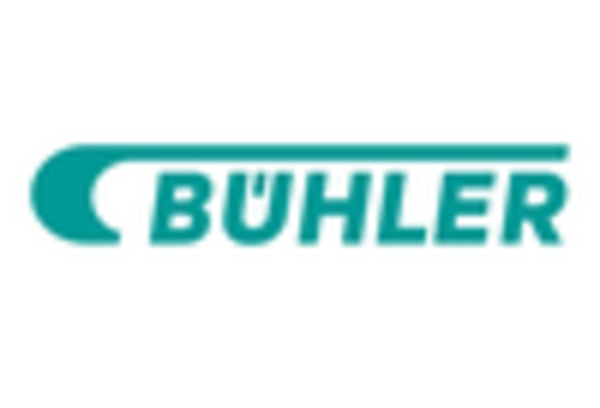Focus on Food Safety and Quality
The emphasis on food safety and quality is becoming increasingly pronounced within the Industrial Food Processor Market. Regulatory bodies are implementing stricter guidelines to ensure that food products meet safety standards, which compels processors to adopt more rigorous quality control measures. This focus is not only a response to consumer demand for safe food but also a necessity to comply with regulations. Market analysis indicates that the food safety equipment market is projected to grow by 5% annually, highlighting the importance of investing in safety technologies. Consequently, the Industrial Food Processor Market must prioritize safety and quality to maintain consumer trust and meet regulatory requirements.
Health-Conscious Consumer Trends
The increasing awareness of health and wellness among consumers is significantly influencing the Industrial Food Processor Market. There is a marked shift towards healthier food options, with consumers seeking products that are organic, low in sugar, and free from artificial additives. This trend is supported by market data, which shows that the organic food market is projected to grow at a rate of 8% annually. Food processors are responding by reformulating products and investing in healthier ingredients to cater to this demand. Consequently, the Industrial Food Processor Market is adapting to these health-conscious trends, ensuring that offerings align with consumer expectations for nutritious and wholesome food.
Rising Demand for Processed Foods
The Industrial Food Processor Market experiences a notable surge in demand for processed foods, driven by changing consumer lifestyles and preferences. As urbanization continues to rise, more individuals seek convenient meal options that fit their busy schedules. This trend is reflected in market data, indicating that the processed food sector is projected to grow at a compound annual growth rate of approximately 4.5% over the next five years. Consequently, food processors are increasingly investing in advanced processing technologies to meet this demand, thereby enhancing their production capabilities. The Industrial Food Processor Market is thus positioned to benefit from this growing consumer inclination towards ready-to-eat and easy-to-prepare food products.
Sustainability and Environmental Concerns
Sustainability initiatives are gaining traction within the Industrial Food Processor Market as consumers become more environmentally conscious. There is a growing expectation for food processors to adopt sustainable practices, such as reducing waste and utilizing eco-friendly packaging. Market data reveals that the sustainable food market is anticipated to expand by 7% over the next few years, indicating a shift towards greener practices. This trend encourages processors to innovate in their operations, leading to the development of more sustainable processing methods. As a result, the Industrial Food Processor Market is likely to evolve, aligning with consumer preferences for environmentally responsible products.
Technological Innovations in Food Processing
Technological advancements play a pivotal role in shaping the Industrial Food Processor Market. Innovations such as automation, artificial intelligence, and machine learning are revolutionizing food processing operations. These technologies enhance efficiency, reduce waste, and improve product quality, which are critical factors for manufacturers. For instance, the integration of AI in processing lines allows for real-time monitoring and adjustments, leading to optimized production processes. Market data suggests that investments in food processing technology are expected to increase by 6% annually, reflecting the industry's commitment to modernization. As a result, the Industrial Food Processor Market is likely to witness enhanced productivity and competitiveness.


















Leave a Comment